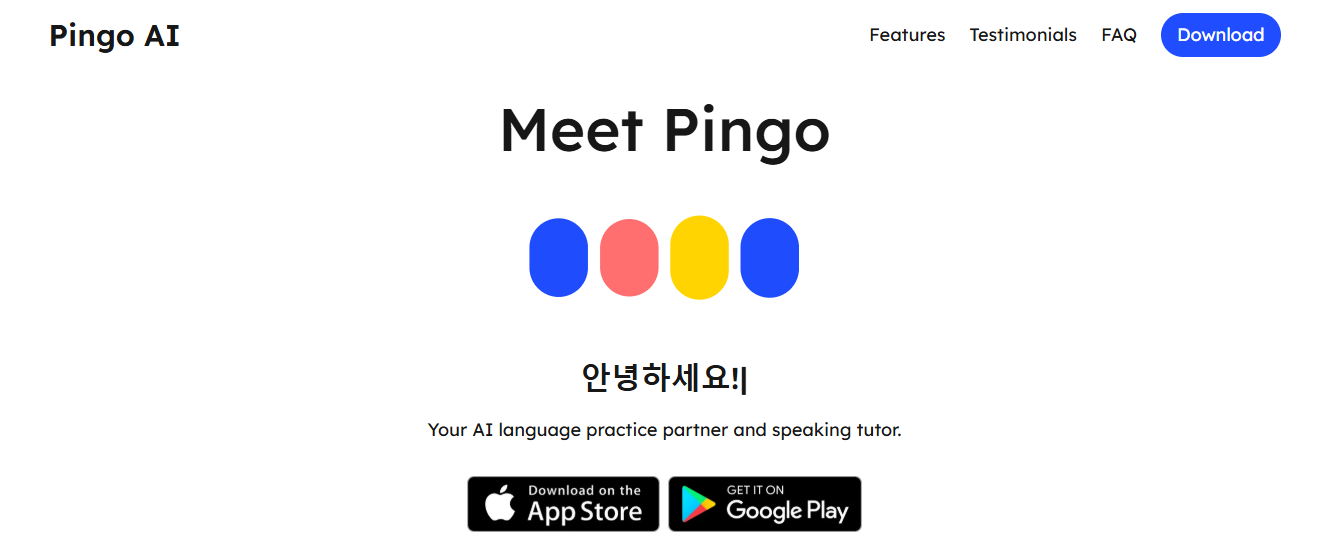A Guide on Choosing the Best Apps for Learning Spanish

Michael Xing, Founder of Pingo AI
You want to order coffee, ask for directions, or follow a Spanish film, but the flood of options makes it hard to pick one path forward. With so many Top Language Learning Apps promising quick gains, you need a straightforward way to compare vocabulary builders, grammar drills, pronunciation practice, spaced repetition flashcards, and live conversation options. This article breaks down lessons, listening exercises, tutor features, and progress tracking, allowing you to choose the best Spanish learning apps that match your schedule, budget, and learning style. What would you like to be able to do in three months, and which app will help you achieve it?
To help answer that, Pingo AI offers an AI language learning app that personalizes practice, provides voice feedback, and tracks your progress, allowing you to test methods, focus on speaking, and stick with what works.
Summary
- Speaking is the common bottleneck for real-world use, with CEDEFOP finding that 70% of Spanish learners require improved communication skills to meet job market demands; thus, delaying productive practice leaves vocabulary passive and fluency stalled.
- Listening practice progresses most effectively when targeted, alternating focused micro-listening drills with broad contextual input in a 3:1 ratio across a weekly plan to build decoding scaffolding before long-form comprehension.
- Interactive features drive retention, with Wirecutter reporting a 20% increase in vocabulary retention for users who engage with interactive app elements compared to those who use passive study methods.
- Spoken feedback matters for accuracy because the Tech in Language Education Report shows apps with speech recognition improve pronunciation by about 30%, making corrective loops essential for habit change.
- Daily micro-practice beats sporadic marathons, as the Language App Usage Study found users who spend at least 15 minutes a day improve their skills roughly 30% faster.
- Market saturation makes selection critical, given that over 50 million people are currently using language learning apps to study Spanish, so prioritize depth and features that force realistic retrieval over sheer content volume.
This is where Pingo AI's AI language learning app comes in, as it provides conversation-first practice, voice feedback, and progress tracking to target speaking gains, simulate realistic dialogues, and maintain privacy.
The Core Skills Every Spanish Learner Needs

Core skills every Spanish learner needs are the four productive and receptive abilities, listening, speaking, reading, and writing, plus the subskills that make each one valuable in the real world:
- Pronunciation and prosody
- Automatic vocabulary retrieval
- Grammar that supports fluid production
- The pragmatic ability to use register and idiom
Train those elements deliberately, and your practice stops being random exposure and starts producing predictable gains in honest conversations.
What Specific Listening Habits Actually Move The Needle?
Listen with tasks, not passively. Target phoneme contrasts, stress patterns, and reduced forms in short, repeated segments; then switch to variable-speed material and different accents to force normalization.
A practical rule to apply is alternating focused micro-listening drills with broad, contextual input in a 3:1 ratio across a weekly plan, as concentrated decoding practice builds the scaffolding that enables long-form listening to become comprehension rather than noise.
How Should We Prioritize Speaking When It Feels So Hard?
Speaking needs structured output:
- Phrase chunks
- Question-and-answer drills
- Storytelling
- Error-focused repetition
It’s all under timed conditions that push automaticity. This skill reliably lags when learners postpone it, a pattern that appears across both classroom and app-based programs: delaying speaking results in a passive vocabulary, while fluency and confidence stall.
That gap matters for careers, too, as CEDEFOP reports that 70% of Spanish learners need to improve their communication skills to meet job market demands, indicating that language ability remains a gating factor for many roles.
What Makes Reading More Than Just Decoding Words?
Beyond decoding, reading practice should train parsing speed, collocation recognition, and structure spotting. Use graded readers to accelerate pattern recognition, then transition to ungraded texts for enhanced comprehension.
Treat reading as vocabulary mining:
- Read for gist
- Flag unknown chunks
- Add multi-word expressions to active practice
- Recycle them into speaking drills
So recognition becomes usable language.
Why Is Writing The Final Stretch For Advanced Competence?
Writing exposes gaps that spoken fluency can hide, because accuracy rules and register shift are more visible on the page. Practice genre-specific tasks, mimic native models, and then reverse-engineer mistakes with targeted feedback cycles.
The emotional reality is that writing feels unforgiving; learners who aim for native-like control must accept iterative correction and slow, deliberate habit formation in terms of morphology and punctuation.
Where Do Pronunciation, Vocabulary Depth, And Pragmatics Fit In?
Treat these as cross-cutting skills. Pronunciation practice targets the most minor units that cause breakdowns, vocabulary depth focuses on high-frequency collocations and functional expressions, and pragmatics trains when to use formal versus casual language.
If you prioritize one cross-skill early, make it speaking-linked pronunciation so that improvements transfer instantly into conversations.
The Input-Output Gap: Bridging the Divide Between Passive Knowledge and Active Fluency
Most learners build skills by first stacking passive exposure, as it feels safe and low-effort. That familiar approach gives comfort, but as soon as real-life conversations require quick recall and repair, the lack of productive practice becomes painfully obvious: fluency stalls, anxiety spikes, and learners avoid speaking altogether.
Solutions like Pingo AI offer ultra-realistic, native-sounding conversational practice through Tutor Mode and instant feedback, enabling learners to replace passive hours with targeted, adaptive speaking drills that increase measurable confidence in just weeks, while preserving scalability and privacy.
How Should You Balance Accuracy And Fluency During Practice?
If your immediate goal is sustained conversation, prioritize fluency drills and functional repairs, then add accuracy cycles targeted at repeated errors. When job-reading and formal writing matter, flip the emphasis: controlled production plus spaced grammar work.
The tradeoff is simple: choose the dominant constraint of your next month, and align all sessions to that one objective; unfocused mixed practice dilutes gains.
A Short Analogy To Lock It In
Think of language skills like a quartet: listening sets the tempo, speaking is the solo, reading supplies the score, and writing archives the performance; if any instrument lags, the whole piece sounds amateur.
However, the most surprising bottleneck emerges when we attempt to scale practice from hobby to career, and what follows will reveal exactly why the choice of app matters.
Related Reading
- Babbel vs Duolingo
- How Much Is Duolingo Max
- How Much Does Babbel Cost
- Rosetta Stone vs Duolingo
- Best Apps to Learn Spanish
- Best Apps to Learn Japanese
- Busuu vs Duolingo
- Duolingo Alternatives
How to Choose the Best Apps for Learning Spanish

Pick the app that maps directly to one clear outcome you can achieve in the next 90 days, and then choose the tool that fits the time you actually have to practice.
I prefer conversation-first options with reproducible feedback and flexible pacing over broad, passive content that feels productive but doesn't translate to real-life conversations.
What Outcome Are You Actually Buying?
Building on the goals you already set, define the single behavior you want to change this month, not the vague hope of “getting better.” If your immediate goal is to order food, you need scenario-based role-plays, quick speech feedback, and error correction that focuses on those exact phrases.
If your deadline is a professional meeting or an exam, the right purchase shifts toward structured lessons and diagnostic tests that reveal weak spots, then target the necessary repairs.
How Will This Fit Into Your Real Life?
If study time is squeezed into 10-minute commutes, prioritize short, interactive drills, offline audio, and automatic progress sync across devices. If you have two longer weekly sessions, prioritize tutor-type blocks or extended simulated conversations. Cost often decides more than content.
Learners on tight budgets repeatedly layer free grammar resources with one focused speaking tool, because that combination preserves cash while producing fast improvements in real conversation readiness.
Why Pick Interactive Features Over Bigger Content Libraries?
Interactive practice is not cosmetic. Wirecutter, “Users report a 20% increase in vocabulary retention when using interactive features in language learning apps.”
This 2025 finding shows that active engagement, not passive exposure, is the mechanism that turns words into retrievable conversation tools.
How Crowded Is The Market, And Why That Matters
The market is saturated, and Spanish attracts the lion’s share of attention, so standing out requires clear selection criteria. Wirecutter, “Over 50 million people are currently using language learning apps to learn Spanish.”
The 2025 figure illustrates why many apps replicate the same surface features, making it essential to evaluate depth, not popularity.
When The Familiar Approach Breaks Down
Most learners default to free vocab drills because they are easy and rewarding in the short term, and that familiarity is understandable. What happens next is predictable: progress stalls the moment you must produce under pressure, practice does not generalize, and confidence drops.
Solutions like an AI language learning app provide highly realistic dialogues, Tutor Mode, and instant, actionable feedback so that learners can convert short, regular sessions into measurable speaking gains rather than scattered exposure.
Which Specific Features Actually Move The Needle?
Choose tools that force retrieval under realistic constraints: timed role plays, adaptive error sequencing, pronunciation scoring with corrective examples, and scenario libraries tailored to your life.
If you need dialect control, verify the regional voice models; if privacy is a concern, confirm how voice data is stored. The tradeoff is straightforward: select the features that minimize the time between hearing a phrase and reciting it back with confidence.
How To Judge Trust And Long-Term Value
Trial properly, not briefly. Commit 10 to 14 days of consistent use for any app under consideration, and track whether your speaking confidence measurably improves in that window. Watch for apps that reward activity with explanations that teach why you erred, not just a green checkmark.
If you must conserve money, prioritize one paid conversational engine over multiple shallow subscriptions, because a single tool that drives speaking practice outperforms many that only build passive knowledge.
The Output Principle: Why Conversation-First Practice Must Replace Passive Input to Build Fluency
Pingo's AI language learning app is redefining language learning through conversation-first practice powered by expressive AI, where learners engage in immersive, real-world dialogue and receive adaptive feedback and personalized exercises across beginner and advanced modes.
Whether your goal is fluency, confidence, or daily speaking practice, start speaking with Pingo AI today for free and experience how easy it can be to learn a language by talking.
That choice feels final until you discover the one habit that makes any app actually work.
Related Reading
- Memrise vs Duolingo
- Best Apps to Learn French
- Lingodeer vs Duolingo
- Pimsleur vs Babbel
- Jumpspeak vs Duolingo
- Best Apps to Learn Mandarin
- Best Apps to Learn Arabic
- Best Apps for Learning English
- Best Russian Learning Apps
How to Make the Most of Your Spanish Learning App

You make the most of a Spanish learning app by treating it like a lab for deliberate practice: design short experiments, capture measurable outputs, and force transfer into authentic speaking situations.
That changes the app from an entertainment feed into a productivity tool that empowers you to achieve absolute conversational control.
How Should I Run Short Practice Sessions?
Run each session as a three-part experiment: a warm-up to cue muscles, one tight performance task where you try to do something new, and an immediate corrective loop that targets the exact failure you hit.
If you time it, treat the performance task like a mini-test, then log the outcome in a brief note:
- What you could do
- What you hesitated on
- The one fix to try in the next session
This pattern makes progress visible and turns vague effort into a tight series of small bets.
Which Features Deserve Attention, And How Do I Use Them?
Prioritize features that force production under realistic constraints, then push them farther. Use speech recognition or recorded playback to compare your pronunciation against native models, and keep an error journal that pairs each mistake with a corrective drill.
That extra loop matters because the Tech in Language Education Report states, “Apps with speech recognition improve pronunciation by 30%.” It shows spoken feedback produces concrete gains in accuracy and fluency.
What Role Should Session Length And Habit Design Play?
Short, repeatable trials beat marathon sessions when your goal is consistent retrieval under pressure, and that matches the evidence: the Language App Usage Study, “Users who spend at least 15 minutes a day on language apps improve their skills by 30% faster.”
It supports making daily micro-practice nonnegotiable. Build those minutes into the gaps you already have, and treat each session as a data point you can tweak, not just a checkbox to maintain a streak.
Targeted Output: The Shortcut to Predictable Fluency
Most people rely on content stacking because it feels productive, but that approach hides a cost.
As lessons accumulate, progress:
- Becomes noisy
- Confidence falters
- You cannot predict what will transfer into conversation
Solutions like platforms with ultra-realistic, adaptive conversation engines and tutor modes provide targeted practice and instant corrective feedback, enabling learners to translate short sessions into reliable speaking outcomes, rather than relying on scattered exposure.
How Do I Measure Whether Practice Is Actually Working?
Measure production, not time spent.
Track three simple metrics weekly:
- Average response latency in seconds
- Percentage of turns requiring repair
- The proportion of target phrases produced without prompting
Record a one-minute speaking sample each week and keep the files; comparing waveforms and self-correction counts across four weeks reveals real gains far better than a subjective feeling of improvement.
How Do I Maintain Momentum When My Motivation Wanes?
Create frictionless accountability and ritualize review. Habit stack the app onto something you already do every day, and add a one-minute public check-in with a friend or study partner twice a week.
Rotate scenarios so practice feels purposeful, not repetitive, and schedule a forty-five-minute synthesis session every ten days where you consolidate recurring errors into a single drill. This gives the brain a weekly chance to turn isolated fixes into automatic responses.
The Confidence Gap: Bridging Skill Measurement and Real-Life Fluency
This method looks clinical because it is, and that’s the point: systematize small wins so confidence grows predictably, not randomly. That simple change reveals the one gap that most learners still encounter.
That missing piece is more personal and surprising than you expect, and it changes everything about how you should practice.
Conversation-First Learning with Pingo AI

Conversation-first learning is about forcing usable language into your muscle memory by practicing real exchanges that require quick retrieval, repair, and tone control, not just recognition.
With the proper scaffolding, those exchanges become the engine that converts vocabulary into fluent responses in everyday situations.
What Does A Conversation-First Session Actually Do?
When I design a speaking session, the goal is twofold:
- Increase the range of comfortable responses
- Tighten the repair loop that corrects recurring mistakes
Good sessions mix predictable prompts with genuine surprise so you practice retrieval and adaptive listening.
The AI’s role is to vary the stimulus intelligently, nudging you from rehearsed answers toward spontaneous replies while keeping cognitive load manageable. Think of it like progressive overload in strength training: you add complexity in small, measurable steps, so performance improves without compromising form.
How Long Should Each Practice Block Be, And What Should It Feel Like?
If you treat practice like a focused work sprint, you get more transferable gains. Shorter sprints tune speed and retrieval, longer blocks build conversational endurance and prosody control. Users spending around 30 minutes per session is a valuable benchmark, based on Pingo AI Usage Statistics, and it supports structuring sessions so you hit both articulation and adaptability without fatigue.
In practice, this looks like a warm-up of mimicry and shadowing, followed by a stretch of unscripted turns, and then focused repair work on the two most stubborn errors that have appeared.
Why Does Targeted Feedback Change Habits Faster Than General Correction?
Errors become habits when they are repeated without precise correction. Targeted feedback isolates the error, shows a clear alternative, and then forces repetition under the same contextual pressure that produced the mistake. This is why explicit corrective drills, paired immediately with a chance to reuse the corrected phrase in a real exchange, accelerate transfer.
The result is measurable: after a month of concentrated conversational practice, a majority of users report real improvement in their speaking ability, according to the Reddit User Survey, which indicates that deliberate, feedback-rich speaking practice produces faster gains than passive study.
What Commonly Fails When Learners Try Conversation-First Methods?
Most failure comes from two predictable mistakes. First, people treat conversations as content, not as a test. They repeat phrases until they sound comfortable, but they never practice recovery from misunderstanding. Second, learners often keep the environment too quiet, never adding noise, conflicting accents, or time pressure that mirrors real-life conversations. Both errors leave learners vulnerable at the moment they need to perform.
The fix is simple and disciplined: introduce controlled unpredictability, and prioritize repair under pressure more often than flawless delivery.
Automated Correction: Replacing Vague Feelings with Scalable Precision
Most teams manage progress tracking with vague feelings of improvement. That works well early on, but as expectations rise, subjective judgment obscures fragile gains, and progress stalls. Solutions like Pingo AI offer a different path, because they simulate realistic conversational contingencies while automating error prioritization and fading prompts.
Teams find that with adaptive tutor features that sequence errors by frequency and difficulty, users get tutor-quality corrective drills at scale, preserving privacy and cutting the friction of scheduling live tutors.
How Do You Push Skill Transfer Into Real Life, Not Just The App?
You force transfer through variation and real-world constraints. Rotate registers, switch dialects, add background noise playback, and require spontaneous topic shifts midway through a role-play.
I conduct three micro-experiments over the course of a week:
- One focused on accuracy in constrained tasks
- One on fluidity with unpredictable prompts
- One pragmatic move, such as politeness strategies and interruption handling
Each experiment targets a different memory system, so skills become robust across contexts instead of fragile tricks tied to specific scenarios.
What Quick Practices Help Maintain Momentum When Motivation Wanes?
When drive falls, tiny, high-signal actions work best. Record a single 90-second response to a stressful prompt, then listen and identify one area for improvement for next time. Use backchanneling drills to practice natural listening responses, which reduce anxiety in honest conversations.
And adopt one accountability ritual: a twice-weekly short public check-in where you state a measurable micro-goal, for example, using three new collocations in a five-minute exchange. These minimal commitments maintain progress without turning practice into a chore.
A Short, Tangible Analogy To Lock This In
Learning to speak under pressure is like learning to drive in city traffic, not on an empty parking lot; you need repeated exposure to small, solvable surprises so your reactions become automatic and calm.
That steady, targeted practice produces results you can feel and measure, but the next issue is the one thing most people still miss about turning practice into a habit.
Start Learning A Language with Pingo for Free Today
If you want to turn rehearsed phrases into honest conversations, consider Pingo AI. When we tested short, conversation-first routines, the pattern became clear: learners stay engaged with realistic dialogue and quit when exercises simply repeat.
Those outcomes, as reflected in Pingo AI, show that 80% of users report improved speaking skills within three months. The Google Play Store has over 1 million downloads, indicating measurable speaking gains on a large scale. Try the free app for two weeks and see if your confidence follows a similar path.
Related Reading
- Best Apps for Learning Korean
- Best Apps for Learning Portuguese
- Best Apps for Learning Russian
- Best Apps for Learning Italian
- Best Apps for Learning German
- Best Apps for Learning English
- Best Russian Learning Apps